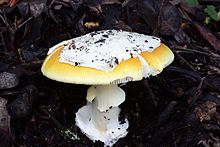
Aleuria aurantia is a widespread ascomycete fungus in the order Pezizales. The bright orange, cup-shaped ascocarps often resemble orange peels strewn on the ground, giving this species its common name.

Tricholoma magnivelare, commonly known as the matsutake, white matsutake, ponderosa mushroom, pine mushroom, or American matsutake, is a gilled mushroom found East of the Rocky Mountains in North America growing in coniferous woodland. These ectomycorrhizal fungi are typically edible species that exist in a symbiotic relationship with various species of pine, commonly jack pine. They belong to the genus Tricholoma, which includes the closely related East Asian songi or matsutake as well as the Western matsutake and Meso-American matsutake.

Amanita velosa, commonly known as the springtime amanita, or bittersweet orange ringless amanita is a species of agaric found in California, as well as southern Oregon and Baja California. Although a prized edible mushroom, it bears similarities to some deadly poisonous species.

Leucoagaricus leucothites, commonly known as the smooth parasol, woman on motorcycle, ma'am on motorcycle, white dapperling, or white agaricus mushroom, is a species of agaric fungus. The species was originally described as Agaricus leucothites by Carlo Vittadini in 1835, and bears similarity to species of that genus. Solomon Wasser transferred it to Leucoagaricus in 1977. While sometimes regarded as edible, the species is suspected of being poisonous due to gastric-upset-causing toxins. It could also be confused with the deadly Amanita ocreata.
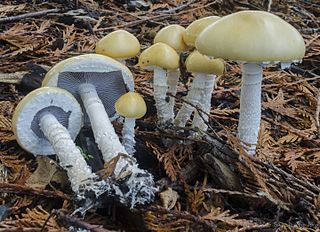
Stropharia ambigua, sometimes known as the questionable Stropharia, is a saprotrophic agaric mushroom, commonly fruiting in leaf litter and wood chips in the Pacific Northwest.
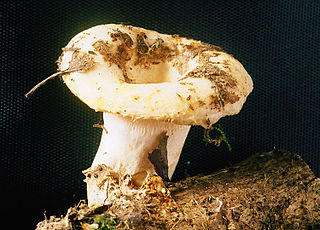
Lactarius resimus is a species of mushrooms in the genus Lactarius, which is considered a delicacy in Russia and some other countries of Eastern Europe when pickled in salt. There it is considered one of three tastiest edible mushrooms, along with Boletus edulis and Lactarius deliciosus, though it is not held in high esteem elsewhere. The mushroom forms a mycorrhizal relationship with birch and with conifers too (pine).

Agrocybe pediades, commonly known as the common fieldcap or common agrocybe, is a typically lawn and other types of grassland mushroom, but can also grow on mulch containing horse manure. It was first described as Agaricus pediades by Swedish mycologist Elias Magnus Fries in 1821, and moved to its current genus Agrocybe by Victor Fayod in 1889. A synonym for this mushroom is Agrocybe semiorbicularis, though some guides list these separately. Technically it is edible, but it could be confused with poisonous species, including one of the genus Hebeloma.
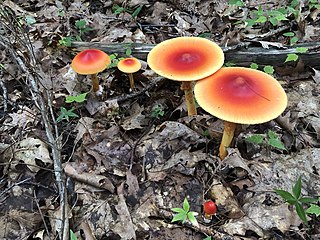
Amanita jacksonii, also known as Jackson's slender amanita, American Slender Caesar, and Eastern Caesar's Amanita, is a North American species of fungus in the family Amanitaceae. It is a reddish-orange colored mushroom species which can be identified by its yellow gills, large, white, sacklike volva.

Tricholoma griseoviolaceum is a mushroom of the agaric genus Tricholoma. It was described as new to science in 1996.
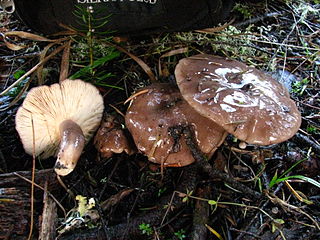
Lactarius pseudomucidus, commonly known as the slimy milk cap, is a fungus native to the northwestern part of North America, often found in coastal and conifer forests. It has a charcoal brown cap, smooth and slimy, from 2–10 cm across, initially flat convex, becoming shallowly depressed. The gills are decurrent, white with a gray or yellow tinge, staining brownish. The stipe is 40–100 mm tall, hollow, brittle. Both the cap and stipe are mucilaginous. The flesh is gray and the latex is milky white, drying yellowish. There is only a slight odor, and the taste slowly becomes acrid. Spores are white in mass, ellipsoid, amyloid, about 8 μm long, with a reticulate decoration on the surface. The species is inedible. It resembles Lactarius argillaceifolius, which has a light orange-gray cap, and eastern North America's Lactarius mucidus. It's edibility is unknown, but the extremely viscid stalk and cap are a deterrent.

Amanita pachycolea, commonly known as the western grisette or the Stuntz's great ringless amanita, is a species of agaric fungus in the family Amanitaceae.
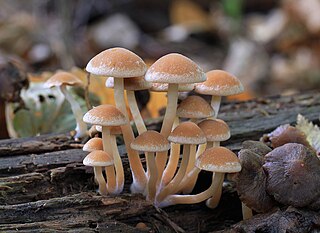
Psathyrella piluliformis is a species of agaric fungus in the family Psathyrellaceae. It produces fruit bodies (mushrooms) with broadly convex caps measuring 2–5 cm in diameter. The caps are chestnut to reddish brown, the color fading with age and with dry weather. The closely spaced gills have an adnate attachment to the stipe. They are initially tan until the spores mature, when the gills turn dark brown. Fragments of the partial veil may remain on the cap margin, and as a wispy band of hairs on the stipe. The stipe is 2–7 cm tall and 3–7 mm wide, white, smooth, hollow, and bulging at the base. Fruiting occurs in clusters at the base of hardwood stumps.

Suillus caerulescens, commonly known as the douglas-fir suillus is an edible species of bolete fungus in the family Suillaceae. It was first described scientifically by American mycologists Alexander H. Smith and Harry D. Thiers in 1964. It can be found growing with Douglas fir trees. Its stem bruises blue, which sometimes takes a few minutes.

Cortinarius alboviolaceus is a basidiomycete mushroom of the genus Cortinarius native to Europe and North America.
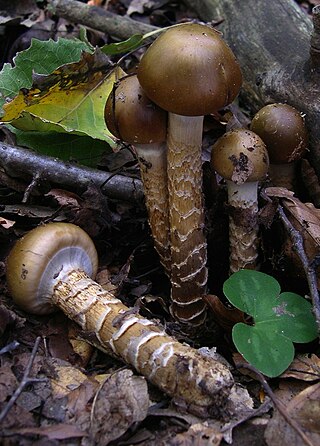
Cortinarius trivialis is a species of inedible fungus in the genus Cortinarius.

Calonarius verrucisporus is a species of mushroom producing fungus in the family Cortinariaceae.
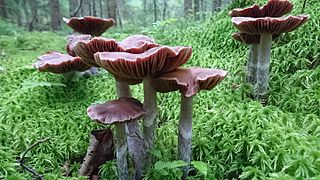
Cortinarius evernius is an inedible fungus in the family Cortinariaceae. Cortinarius evernius is grayish brown or grayish purple. The cap is convex and it has remnants of the membrane. The stipe is grayish purple and it has remnants of the membrane in a zig-zag pattern. The gills are greyish purple in the beginning, then brownish. The mushroom grows in coniferous forests for example, near swamps.

Hygrocybe flavescens, commonly known as the golden waxy cap, is a species of Hygrocybe described from Michigan. It is considered nonpoisonous to humans. The species can be found in various forests and woodlands.

Psathyrella corrugis, is the type species of the basidiomycete fungus genus Psathyrella and family Psathyrellaceae. Originally described from Europe as Agaricus corrugis, the species is considered non-toxic but lacking in flesh, flavor and texture. It is inedible.

Candolleomyces candolleanus is mushroom in the family Psathyrellaceae. It is commonly found growing in small groups around stumps and tree roots on lawns and pastures in Europe and North America. In 2014, it was reported from Iraq. The coloring varies between white and golden brown. The cap is tan when young, growing to 2–8 cm (1–3 in) in diameter, initially conical, later becoming rounded and finally with upturned margins in maturity. The cap margin is irregular and radially asymmetrical—a defining characteristic of this species. It can retain veil fragments on the edge and center. The white stalk is 4–10 cm (1.5–4 in) tall and 3–7 mm wide. The spore print is purple-brown, while spores are smooth and elliptical, measuring 6.5–8 by 4–5 µm. The specific epithet candolleanus honors Swiss botanist Augustin Pyramus de Candolle.
